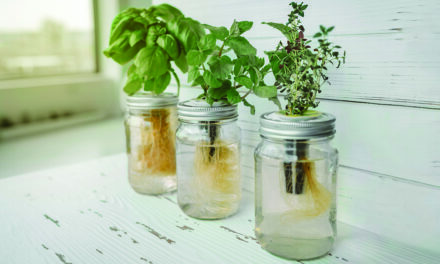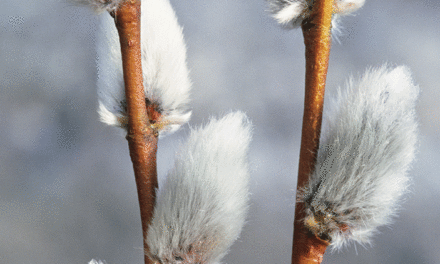
Wine bottles used as edging for part of backyard landscape first got strange looks from neighbors, said Vienna resident Justin Glessner, but he said then some began to add to the bottle collection. (Photo by Debra R. Messick)
He holds a degree in landscape design and grew up on a farm.
But Justin Glessner’s personal terrain management plan isn’t your garden variety growing scheme.
This summer marks his second season transitioning the yard surrounding the 1930s era home in Vienna, Md., where he and his wife moved a year and a half ago into an “edible” landscape — a smorgasbord of greenery as appetizing as it is decorative — garnished with an abundant supply of salvaged and repurposed natural materials.
Where once there was neatly manicured lawn, a bountiful crop of nitrogen producing white flowering clover was sown to best prep the groundwork for a future harvest of blackberries and blueberries.
Tucked tastefully behind a corner border of tulips taken from his grandmother’s bountiful flower garden lies a tempting trove of onions, tomato and pepper plus herb plants which will create the couple’s beloved spaghetti sauce. Savory mint varietals including chocolate, strawberry, and spearmint will flavor their favorite teas.
Nearby, nestled beneath a Sugar Maple tree’s shade branches, lettuce heads will emerge to provide verdant eye candy before becoming salad.
The soil, meanwhile, serves up an ecofriendly habitat for worms, helping enrich the growing medium and increase the catch on future fishing trips.
Festooned alongside the house exterior is a border composed of climbing spinach plants, while raised beds buttressing his screened porch house additional herbs and at least one native heirloom rose featuring flavorful and nutritious fruity knobs, shared by a neighbor.
Adorning the home’s front area is a decorative garden bed of sawgrass with mulch made up of clam and oyster shells plus American hazelnut hulls, an all-natural non-dyed ground cover.
The squirrels drawn to the bed to forage for nuts among the shell casings don’t bother Glessner in the least; as a boy he enjoyed watching his grandfather feed and care for a variety of the furry critters.
Where the garage once stood, Glessner created a welcoming backyard fire pit, framed with 4 x 4s which once supported fences used to keep horses at Assateague National Wildlife seashore from munching on protected vegetation, as well as wooden planks which had borne the remnants of the famed Wye Oak after it was felled during a storm in 2002 and housed at the DNR John A. Ayton State Tree Nursery in Preston, where Glessner worked under a grant directing seedling production. (Milled pieces from the Wye Oak were made available to Maryland artisans and others to help preserve it for posterity.)
The driveway edging was sourced from recycled black irrigation pipe he remembered seeing strewn in the woods near his grandparents’ house as a youngster and which miraculously had remained.
While his Eastern Shore neighbors could appreciate such hard work and resourcefulness, his unconventional ways raised a few eyebrows, especially at the start.
Seeing his grass grow a bit longer than folks were accustomed to, kids would gently remind Glessner that it might be past time to cut it, assuming he’d forgotten.
Older people, meanwhile, sometimes cast sidelong looks at his habit of using empty wine bottles as border edging (Glessner had a steady supply while working as a vintner for nearby Layton’s Chance winery.)
The concave bottle bottoms provide perfect “rain pool” receptacles which keep helpful insects and other critters naturally hydrated, he added.
Slowly but surely though, his adventure in nontraditional cultivation has been growing on the community he’s happily adopted as home.
When an initially dubious neighbor recently donated his used wine bottle stash, Glessner considered it a sign that he was doing something right. Other neighbors have also contributed to the cause, including woodworker David Warfield, who shared with him the native rose rhizome, and whose stash of leftover sawdust from handcrafted dulcimers serves as a vital ingredient in Glessner’s rotating covered compost bin.
While putting down roots in the historic town on the Nanticoke River is a relatively recent development, Glessner’s formative years were spent in the not too distant vicinity, near northern Dorchester County’s El Dorado community.
Growing up on a farm, he spent a good chunk of his childhood outdoors, exploring not only his own backyard but his grandparents’ farm as well.
While attending North Dorchester High School, he earned money doing yard work for neighbors. After school, he migrated to Tennessee and found work on a cattle ranch, soon becoming the official state caretaker of the property, helping to manage 16,000 acres including chickens and other livestock.
In the aftermath of the recession, Glessner decided to seek a trade as well as an education and studied landscape design at Chattanooga State College. For what would become a life altering class project he researched the history behind postmodern traditional mainstream garden practices including tightly manicured and heavily fertilized lawns, which have in recent years been shown to threaten ecosystems, especially fragile watersheds like the Chesapeake Bay area where he hailed from.
While still living in a remote area of Tennessee, Glessner was able to freely experiment, aquatically cultivating green beans in open sections of porch handrail, among other things.
One day a neighbor from several miles down the road paid a visit, admitting to his own curiosity, but also that he had been sent on the reconnaissance mission by ladies of the local church, to ensure that no laws, moral or otherwise, were being broken, Glessner recalled with a smile.
They might have been pleasantly surprised to learn how much he was inspired by the Amish “quilt” styled vegetable gardens of Lancaster, Pa., which motivated him to make drawings of patchwork plantings he hoped to one day realize on his own property.
With each new phase of his edible backyard, Glessner said he hopes to inspire others to envision new possibilities in the way they can use the resources they have readily at hand, helping themselves, and the land itself.





